An Islamic wedding is a special occasion, with the Nikah being more than just a coupling of two individuals, but a solidification of a partnership through the teachings of Allah. And like any good party, it all begins with a wedding invitation. But, unlike regular cards, an Islamic wedding invitation has spiritual and cultural value. It’s not just about where and when it’s about how to pay homage to your faith and heritage while also welcoming your loved ones to share in your special day.
So how do you design an invitation that is beautiful, reverent and uniquely your own? Let’s step into the world of Islamic wedding invites and find out what makes them truly divine.
Why the Wedding Invitation Matters
Your wedding invite is the first glimpse your guests get of your wedding day. It’s the first clue that guests will get to the tone of your party. Is it formal or casual? Traditional invite or modern invite? A tastefully selected Islamic wedding invitation does more than share details it communicates values and aesthetic.
Infusing Style with Faith and Culture
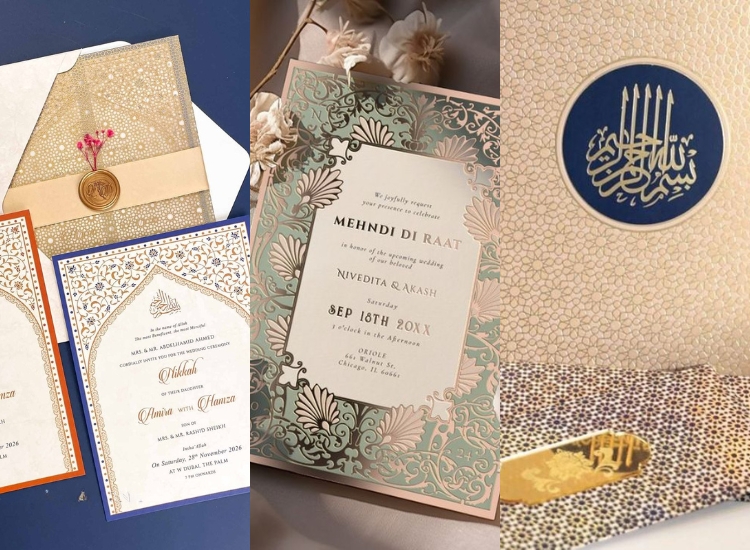
An Islamic wedding invitation is the epitome of marriage, and a Religious wedding card is the heart of the marriage. So let’s go over some classic design elements:
Arabic Calligraphy
Beautiful Arabic calligraphy usually takes center stage. This traditional first line, “Bismillah hir Rahman nir Raheem” (In the name of Allah, the Most Gracious, the Most Merciful), is no doubt meaningful.
You could have verses from the Quran, Islamic blessings, or the names of the couple displayed on the card in styled script for added beauty.
Geometric Patterns
Background of beautiful muslim wedding invitation card with captivating geometric patterns. These complex designs epitomise balance, harmony, and spirituality ideal symbolism for a marriage.
Floral Motifs
Flowers are synonymous with growth and new beginnings, so they work well as accents for wedding cards. Think Persian roses, Mughal lotus, or fragile vines curling around edges.
Symbolic Colors
Colours with meaning in Islamic wedding invitations:
- Gold and silver: Wealth and festivity
- Emerald green: Symbol thereof in the Islamic religion
- Ivory and White: Purity and Simplicity
- Deep blue or burgundy: Magnificent elegance
Mosque & Dome Illustrations
Mild mosque silhouettes, arch, or dome on the card can create an air of religious sanctity and yet not too flashy.
What Details Should Be Included?
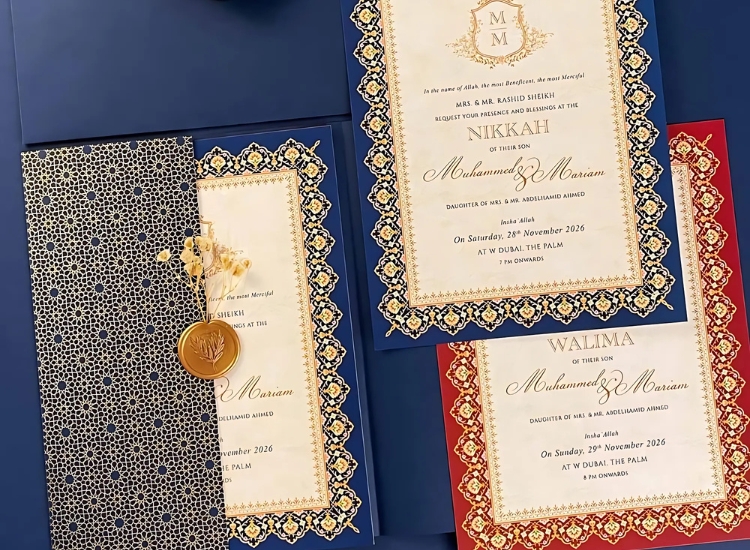
And no matter how beautiful your card is, absent details could leave intended invitees in the dark. Here’s what to include:
Couple’s Names: Type out the full names in a pretty clear font with the bride and groom’s first names emphasised.
Names of the Parents: In Islamic families, weddings are events in which the families are the main focus. Names of the parents were the official ones, a mark of respect and importance.
Date & Time: Date and time of the Nikah and Walima. If you try to schedule saved queries in Intuition without including and being explicit on AM/PM, it will cause trouble.
Venue Information: Type the complete address of the venue. If the Nikah and Walima are in different locations, provide each separately.
RSVP Info: Include a phone number, email or RSVP link. Add a due date so that guests will be responding on time.
Dress Code (If Applicable): If you have a modest dress standard, you can give a subtle hint to your guests so they can plan for the occasion.
Blessings and Duas: Add a dua for the couple’s new life or a brief sentiment. It is emotive and holy.
Islamic Wedding Invitation Wording Examples
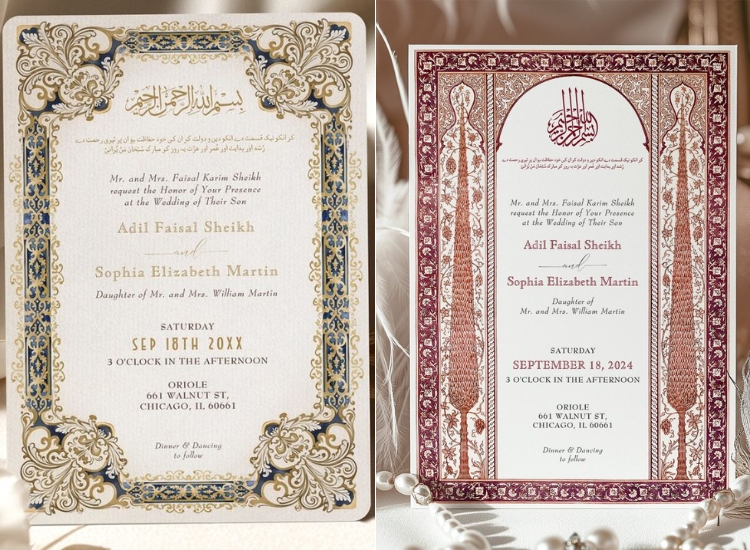
The tone of your invitation is as important as what it says. It should have a warm, inviting, respectful feel to it.
Example 1: Traditional Format
Bismillah hir Rahman nir Raheem
And by the grace of Allah (SWT).
Mr. and Mrs. Ahmad Khan
would be pleased if you could attend
On the occasion of the Nikah of their dear daughter
Ayesha Khan
with
Mohammed Ali
Son of Mr. and Mrs. Yusuf Ali
“Five o’clock in the afternoon of Sunday 15th September 2025
[Venue Name & Address]
Walima Reception on 16th September, same place.
Example 2: Casual & Contemporary
We’re getting married!
Please come to share with us in a special day as we joyfully announce the Nikah of
Amina & Zayd
With love, joy, and duas
on Saturday, Nov 8 2025
Ceremony: 3 PM | Dinner: 6 PM
RSVP: 555-123-4567 by Oct 15
Modest attire requested
Adding Modern Touches to Traditional Cards
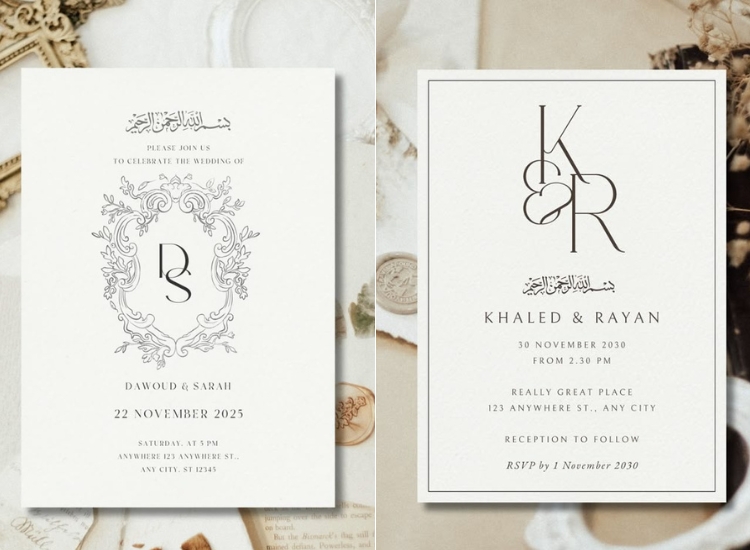
You don’t have to adhere to tradition exactly. Here’s how you can mix old with new:
Digital Invitations: Earth-friendly and easy, e-cards are great for out-of-towners. New templates even offer the ability to include animation and music!
Custom monograms or logos: Design your own custom symbol that combines your initials with something personal or indicative of your personality, such as a crescent moon or a flower.
Wedding Website: Please provide a link to your personal wedding website, which should contain information about your event, dress code, hotels nearby, gift registries, etc.
YouTube Some Archived Moment: Some couples share a sweet, classy shot from their archives of classy shots—think about your comfort with modesty.
Popular Printing Techniques for Luxury Finishes
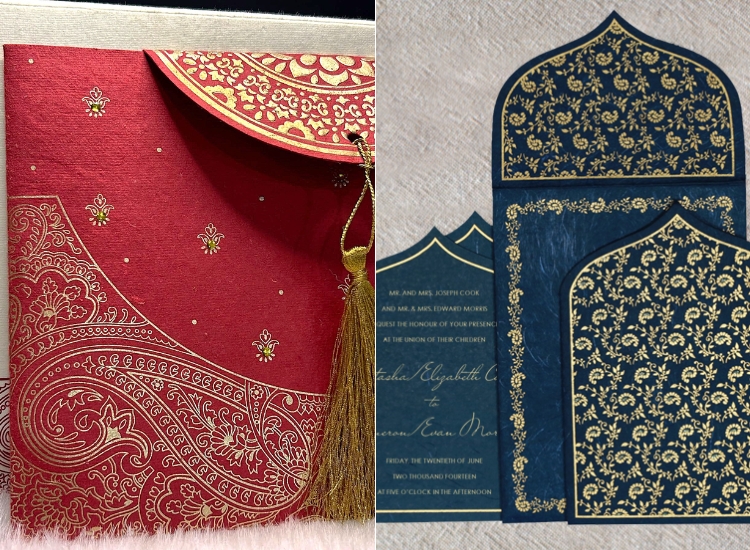
Looking for more of a luxury feel for your invitation? Consider these printing styles:
Foil Stamping: (Optional) Metallic foil that adheres to the names or borders, great for gold or silver.
Letterpress: Results in a luxe, tactile finish when a design is securely pressed into paper.
Screen Printing: rich and vibrant colours are visible wonderfully on this age-old method.
Laser Cut Shapes: Ideal for embellishing the edge of the card with lace-influenced elegance.
Matching Stationery for a Cohesive Look
A lovely invitation is just the start. You can also match:
- RSVP Cards
- Mehndi/Reception Invites
- Menu Cards
- Thank You Notes
- Favor Tags
Stick with the same fonts, colours and themes.
Where to Buy Islamic Wedding Invitation
And if you’d rather do online shopping instead, head over to www.123weddingcards.com, who is well-versed in the ways of Islamic wedding etiquette and aesthetics. Offer tailored services with respect for religious and cultural sensitivity.

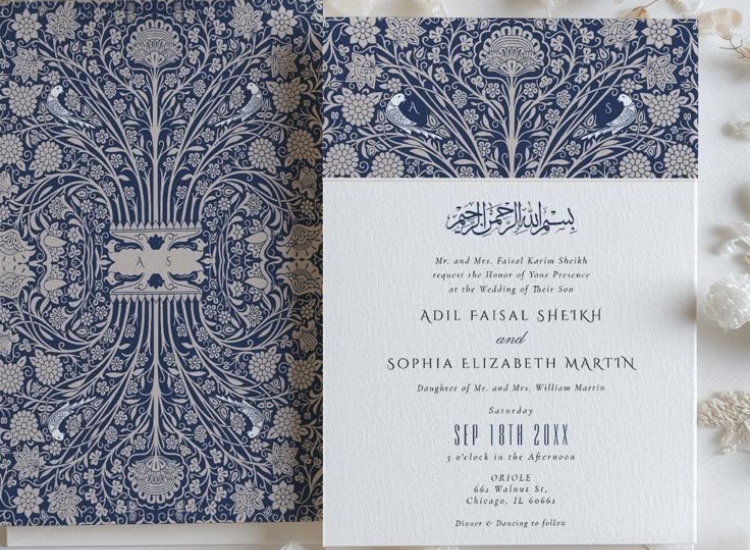
Comments are closed.